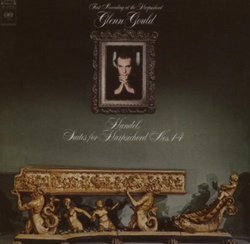| All Artists: George Frederick Handel Title: Handel: Suites for Harpsichord Nos. 1-4 Members Wishing: 0 Total Copies: 0 Label: Sony Bmg Europe Release Date: 9/3/2007 Album Type: Import Genre: Classical Styles: Chamber Music, Forms & Genres, Suites, Historical Periods, Baroque (c.1600-1750), Classical (c.1770-1830) Number of Discs: 1 SwapaCD Credits: 1 UPCs: 886971482126, 0886971482126 |
Search - George Frederick Handel :: Handel: Suites for Harpsichord Nos. 1-4
CD Details |
CD ReviewsA BIZARRE CURIOSITY John J. Schauer | Chicago, IL USA | 01/26/2010 (1 out of 5 stars) "I have never been a fan of Glenn Gould. His performances of Bach's music on the piano probably seemed like a revelation when he first burst on the scene in the early 1950s. At that time, Bach's keyboard music was routinely played on the piano in a very Romantic way. Since a piano has a much rounder sound than a harpsichord--less of a percussive attack--it is difficult for a piano to articulate counterpoint as cleanly as a harpsichord can. Gould's solution was to play almost everything in an unrelieved semi-staccato, a trademark of his playing throughout his career. It made the contrapuntal lines stand out better, but at the expense of any sense of legato. After a very short while, it becomes extremely tiring.
For this album, however, Gould actually performed on a harpsichord as a sheer expedience--his piano was damaged and the recording sessions were already scheduled, so he pressed into service (in his own words) the "one harpsichord in the world that I can play, and that's one that many pro-harpsichordists turn up their noses at--the Wittmayer." He is right there--Wittmayers fall into the category of "German factory instruments," which today you would have trouble giving away. Whether the one he uses is a particularly weird instrument or it just sounds that way because of the way he plays it, is difficult to ascertain. (A note here to everyone--and there are many--who comment in their reviews that they prefer Baroque music on the piano because they don't like the sound of harpsichords: you should reserve judgment until experiencing a variety of harpsichords in person. Harpsichords are probably the most problematic of all instruments to record; mike them too close, and you get an explosion of percussive attacks and releases; mike them too distant, and they sound far weaker and "tinkly" than harpsichords actually are. And the excessive reverberation present on many recordings turns the instrument's sound into a jangling blur. I adore harpsichords, but there are many, many recordings that make me want to run from the room screaming.) Like many pianists who think they can play a harpsichord without proper training, Gould certainly lacks a proper harpsichord touch--one can hear the jacks thumping against the jackrail from his excessively heavy touch--and his notions of registration are strange, to say the least. He betrays his almost total ignorance of harpsichords when he claims his Wittmayer "lacks certain amenities such as a lute on the four-foot, which I would dearly like to have and which any self-respecting harpsichord offers." Really? I have studied and played harpsichords for 40 years--from modern "revival" instruments by Challis and Rutkowski to "authentic" instruments by Hubbard and Dowd--and have never, either in person or even via written description, encountered one with a "lute on the four-foot." (The "four-foot" refers to a separate set of strings that play one octave higher than written.) By "lute" he presumably means what is also called a buff stop, whereby a wooden rail slides to press small felt pads against the strings, giving them a dead, pizzicato sound. It appears commonly on 8-foot registers and is included on most modern harpsichords not because it was a common feature of old instruments--it was not--but because it is a mechanically simple and inexpensive way of adding another "sound" to the harpsichord's palette without having to add another set of strings or jacks. It is an effect that should be used extremely sparingly. On these recordings, Gould, still trying to make Baroque musical lines sound as detached and mechanical as possible, over-uses the buff stop to a remarkable extent (the opening movement of the second suite is a good example). Elsewhere, he often combines a buffed 8-foot register with the unbuffed 4-foot register; presumably he would have preferred to have both registers buffed to make the sound even more percussive. A harpsichord already has a very distinctive "attack" for each note; couple that with detached playing and overuse of the buff stop, and you lose virtually all sense of line. Occasionally Gould plays a movement without gimmicky registration and with a nearly legato line, but those moments are few and far apart. His tempos are what you would expect from him--often far too fast, so that the music sounds merely hectic and frenzied rather than lively. At least his trademark mannerism of singing (or groaning) as he plays seems relatively absent. Some of his fans see that practice as endearing, proof of Gould's inspiration and involvement with the music; I see it as an appalling lack of discipline that no sane music teacher would tolerate in a student. If you are curious to hear what Glenn Gould would sound like on a harpsichord, this recording will answer your questions. If you are a fan of Handel's harpsichord suites, or of the instrument itself, you can safely pass on this exercise in the bizarre. " |

